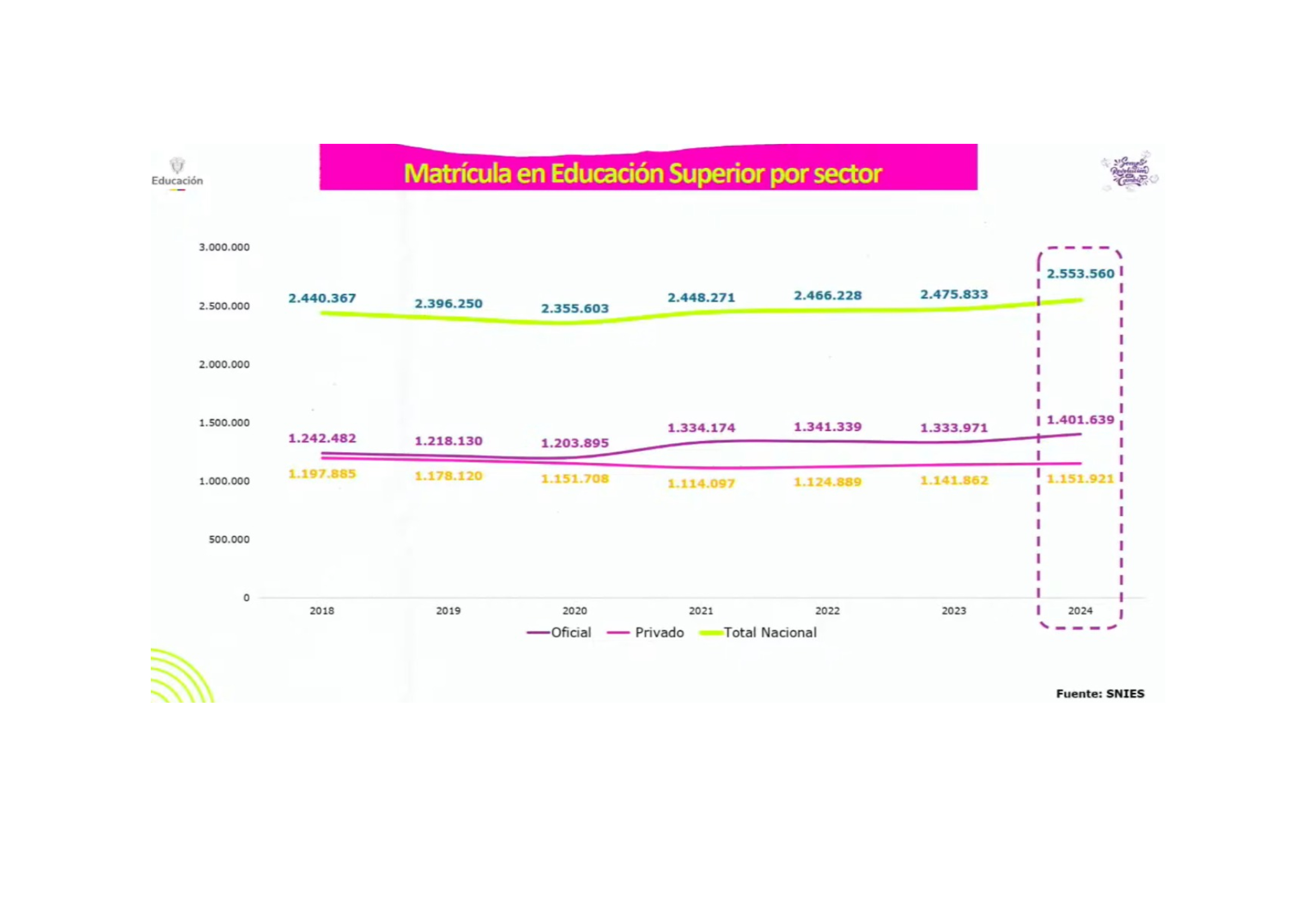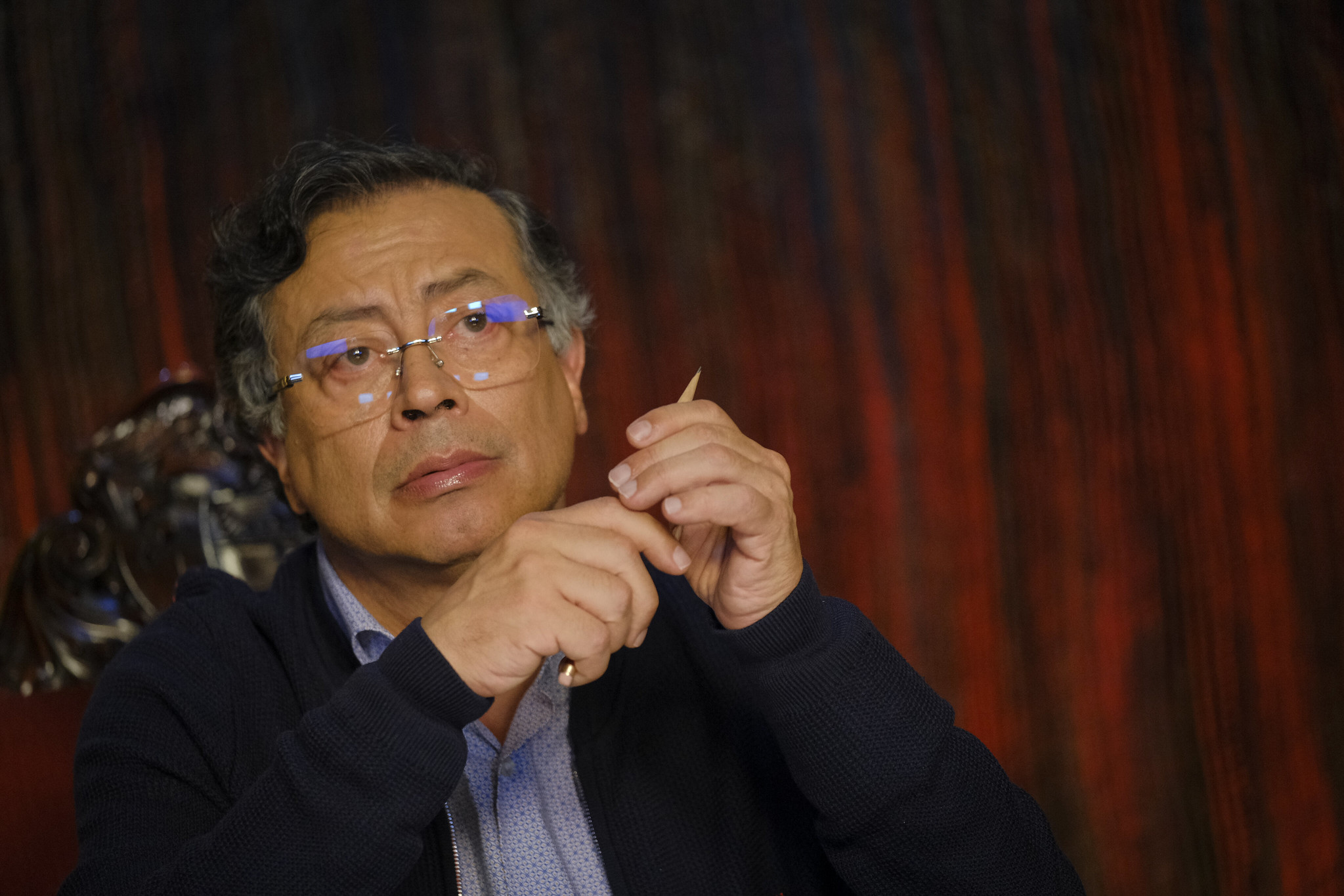President Gustavo Petro provided erroneous data on higher education: It is not true that previous governments did not increase university enrollment.

During his speech this Tuesday, President Gustavo Petro revisited the higher education figures presented by the Ministry of Education last week , which have been controversial not only by the opposition but also by leading education sector analysts. He also conducted several analyses of the sector, which EL TIEMPO compared with official figures, concluding that some of them are misleading.
The president began his address and presentation of data by addressing what he called "censure" of his administration's achievements. Regarding education, he emphasized the number of new university spots created, which, according to his administration, reached 190,000 by 2024 and plans to reach a total of 500,000 by 2026.
“This is one of the Colombian government's greatest achievements. We reached 190,504, the cumulative total, a figure that confuses some, except that here, with this figure, flow math was used, so it's not a mistake. The parliamentarian (referring to Catherine Juvinao), who comes from a neoliberal background… confuses it. These are new quotas for university entrance.”
However, the congresswoman isn't the only one questioning the calculation; experts are also doing so, pointing out that President Gustavo Petro's government is confusing newly created quotas with the increase in enrollment for first-year students, also known as primiparous students.
The figures, which were presented by the Ministry of Education, are derived from the National Higher Education Information System (SNIES), which measures several indicators. In this discussion, two are the most important: First Year (students entering undergraduate programs in the first semester) and Total Enrollment (the total number of students enrolled in the system).
Thus, the figure of 190,504 corresponds to the first year, which, for analysts like Francisco Cajiao, while positive, does not count all of them as new places: "The question for defining the new places is how many young people there are in total in the system. Because if there are only 87,000 more in total, that is the net increase . The total enrollment and the first-year enrollment are two figures that refer to two different things."
And he added: "If not, we're talking about the same quotas as before, but filled by new people."
In other words, a higher education space is filled by a first-year student, but also by someone in their sixth or seventh semester, so the total number of spaces available at institutions would be the same as the total enrollment.
This is what Ricardo Rodríguez, an education analyst, says: “When the president talks about flow math, he says that dropout rates and graduation rates must be taken into account. This is true, but the problem is that the National Development Plan never specifically addressed the first-year indicator, and the narrative has always been about quotas. Therefore, even when a young person drops out of school or graduates, a quota is freed up for another student to use, so quotas aren't created there.”
He added: "Dropout and graduation, this flow that President Petro speaks of, has always existed and has never generated controversy regarding the way the system has always understood the creation of quotas (which is based on total enrollment), until now."
It's worth remembering that the National Development Plan mentions the 500,000 target in two places: one referring to new students, and the other to new places, which is why confusion arises regarding how the target should be measured.
But it's worth remembering that on previous occasions, when President Gustavo Petro referred to this goal, he explicitly stated that the idea was to increase the number of students in the system from 2.4 to 2.9 million , that is, referring to the total enrollment indicator and not to the first year.
Thus, SNIES figures show that the year 2024 closed with a total of 947,109 new first-year students, representing the more than 190,000 people President Petro mentioned compared to the year 2022, the base year.
However, if the total enrollment figures for the system are taken into account, the government would be far from meeting the goal of 500,000 new places.

Increase in higher education enrollment. The increase is seen as 87,000. Photo: Ministry of Education
Thus, 2024 closed with a total of 2,553,560 , which implies 87,332 more students than the base year, which was 2,466,228 in 2022. This would mean that the Government would have actually achieved half of the places it announced.
And the figures would be even lower if only undergraduate enrollment (professional, technical, and technological programs) were considered, excluding postgraduate programs. In this regard, there were 2,346,757 undergraduate students in 2024, compared to 2,284,637 in 2024, i.e., 62,120 more students. In fact, in 2023, undergraduate enrollment fell by 4,000 compared to the previous year.
“The creation of places in higher education was 0 in 2022” This is a false statement. Speaking with EL TIEMPO, Education Minister Daniel Rojas stated that 2022 is used as the base year for the measurement because it is from then that the results of the Petro administration can be measured. This is very different from saying that the creation of quotas before that year was null.
In fact, for 2022, total enrollment was 2,466,228 students, the highest in history up to that point. A year earlier, in 2021, it was 2,448,271 , and before the pandemic (2020, the year in which the lockdown was reflected in the reduction in enrollment, something that under normal conditions would not have occurred), it was 2,396,250 for 2019. If you want to see how it rose even earlier, in 2014, during Juan Manuel Santos' first government, total enrollment was 2,220,652, so, except for years of decline such as 2019 and 2020, total enrollment had been growing year after year.
Furthermore, Petro said that "during the entire Duque administration, there were only 15,000 new openings through the Ser Pilo Paga program."
Once again, the numbers contradict this: Total enrollment in Duque's base year (2018) compared to his final year (2022) increased by 26,000, which is less than what the Petro administration already achieved, but more than the president claims. And to this, it should be noted, enrollment was affected by the pandemic, a phenomenon that affected not only enrollment in Colombia but worldwide, which is why the analysts consulted by this newspaper prefer to refer to them as atypical years, and therefore not comparable.

President Gustavo Petro in his speech. Photo: Presidency
President Petro said: "Why did enrollment in private universities increase? Because by taking away their subsidies , they risk perishing. That's why they're doing what they had to do: lowering tuition prices. That's an achievement of this government."
However, this is not true. In general, tuition costs at higher education institutions did not decrease. On the contrary, as established by law, universities can increase their tuition rates in line with the CPI, and even a few points higher if they meet certain conditions.
What did happen is that many institutions voluntarily chose to freeze their prices— that is, neither increasing nor lowering them—given the potential impact on some students if the government were to withdraw interest rate subsidies on Icetex student loans.
EL TIEMPO investigated several private universities about the reasons for the increase in their enrollment, and they attribute it to various factors, such as the creation of new programs more suited to the needs of young people, the creation of internal credit lines that replace what Icetex previously did, as well as the growth in enrollment in technical and technological programs, which are usually cheaper than professional programs and are included in the Ministry of Education statistics.
On the other hand, President Petro asserted that it is cheaper to "educate a young person in Europe than at the University of the Andes in Colombia."
There are nuances to this. At the University of the Andes, an undergraduate degree costs $25,460,000 (excluding Medicine), or €5,360 per semester and €10,720 per year.
In Europe, there are cheaper universities than that, and many more expensive ones. But that's true for a native student. For foreigners, the prices rise considerably. For example, in Spain, the main academic destination for Colombians in the Old Continent, the annual tuition fee for a foreign student ranges between 5,000 and 18,000 euros, according to the Spanish government.
Added to this are food, accommodation, and administrative costs, which can easily amount to between 2,000 and 3,000 euros per month.
What is true The SNIES figures, presented by Minister Rojas and President Petro, do show that higher education enrollment increased in 2024 in both public and private institutions.
Furthermore, the highest coverage rate in history (57.53 percent) was reached, and the free education policy now covers more than 960,000 people, a figure that has increased considerably in recent years. Furthermore, the immediate transition rate to higher education (the percentage of recent high school graduates who enter higher education) reached 45.94 percent.
MATEO CHACÓN ORDUZ | Education Deputy Editor
eltiempo




